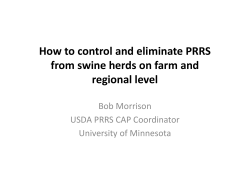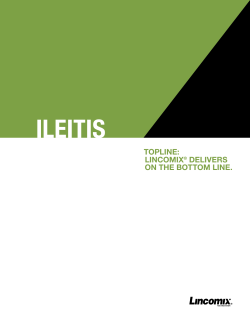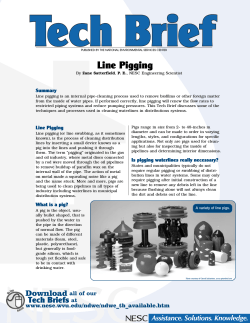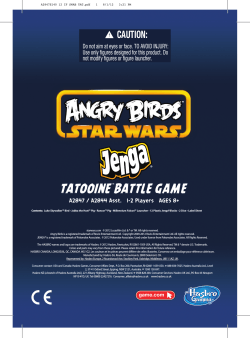
What is the cost of disease? John S Richardson
What is the cost of disease? John S Richardson Sponsored by Garth Partnership South-east Scotland Pig Discussion Group 2011 The cost of disease – topics to be covered • • • • • • • • Profit – what is it, and what factors affect it? Cost of disease – other people’s views Herd performance - QMS and UK Value of performance What are marginal pigs worth? Cost of disease methodology – Parvovirus, EP & PRDC How to control PRDC (Porcine Respiratory Disease Complex) Conclusions Reasons for keeping pigs? Because we like them Because we always have They fit the farming system There is an empty building to fill As a commercial business … if so ………are you keeping pigs or are the pigs keeping you? Profit = Net Output – Total Costs (COP) / kg / pig / sow / herd Number of pigs x Weight of pigs x £ / Kg @ base price x Quality premium x Frequency of output & Valuation changes Variable Costs 76% p/ kg d wt Feed 59% 85p Vet & Medicines 2.0 2.9 Electricity 3.0 4.4 Breeding repls. 0.9 1.4 Levies & Ins. 1.9 2.7 Water Bedding Sundries / misc. 7.4 10.7 Transport 2.6 3.7 Fixed Costs 24% Labour 9 Building & Equip. Depr. Repair,& finance 13.8 Interest on Capital 1.4 Total production cost y/e Dec 2010 13p 20 2 145.8p @ 21 pigs sold / sow / year at 78 kg dwt Factors affecting herd performance Genetics 1% Health 2% Housing Nutrition 13% 59% Management 9% Realistic responses to health improvement High Health Performance Improved Health Opportunity / Potential Reality Normal Health Normal health upgrading to Improved health requires improved management of the current health status (Knowing what you’ve got – and managing it) The effect on performance and cost of disease Disease Performance effect Enzootic Pneumonia (EP) 34-50 g / day loss of daily gain PMWS Mortality up to 25% Swine Influenza Loss of growth PRRS Extensive Ileitis Cost / pig Author ? Klawitter et al (1988) c£10 Done (2002) c£24 / sow Madec (1992) £441 million Nationally in USA Kliebenstein et al (2005) FCR 0.05 – 0.2 +3 weeks to sale £0.92 - £13.87 Lawrence (1999) Mange Daily gain -9.2% FCR -12.5% ? ? Cargill and Dobson (1979) EP and APP 30.3-58.8g loss of daily gain ? Baekbo et al (2002) EP Very severe £5.71 Burch et al (2007) Disadvantages of some of the previous estimates of the cost of disease Presume that other pathogens are not present / or are not significant Do not indicate disease severity (acute or chronic) or duration Often evaluated irrespective of prevailing economic conditions Some show physical performance depression, not economic losses Rarely show cost of treatment and the value (cost) of lost of performance Perceived of less relevance when sourced in other countries So how long is the piece of string? It’s not so much about the disease – as it is about its effect on performance How comfortable are you with: Precise production performance parameters for your herd? the effect of performance on the economics of pig production? the effect of disease on performance and profitability? Performance range in UK herds – June 2011 Weight range 7 – 103kg 77.25 kg dead weight Bottom third Top third Daily gain (g / day) 586 700 114 £1.46* F C R (feed at £229 / T) 2.74 2.25 0.39 £8.93 Mortality % 6.1 3.9 2.2 £1.80 - - - £12.19 Cost / kg Dead wt. gain (p) Year ending June 2011 92.7 62.7 30.0 £23.2 Weaned / sow / year Indoor 19.7 26.4 6.7 £155 / sow Weaned / sow / year Outdoor 19.0 23.05 4.05 £94 / sow Total / pig sold Difference Difference (Physical) Value / pig *based on 64p / 50g / day and excluding FCR effect The cost / value of changes in pig performance - summary September - November 2011 Parameter changed for pigs 7-107kg Value / pig Variables influencing the value sold 0.1 F C R (ave. feed cost £229 / T) £2.29 Feed costs and weight range c10p / pig / £10 / tonne cost change 1% Mortality £0.82 Costs, sales value, weight at death 50g daily gain - Extra throughput same weight 50g daily gain - Same throughput heavier weight 1 Marginal pig finished Input costs, sales values, FCR £0.64 output + *But must NOT ‘double count’ FCR £1.62 FCR = £2.26 £3.25 £53 Input costs, sales values, incremental FCR Input costs, sales values, breakeven point, performance The concept (and the reality) of the marginal pig Marginal pigs are those pigs produced in excess of the break-even cost The concept (and the reality) of the marginal pig Marginal pigs only incur their own direct costs of production, none of the unit’s fixed costs, or any of the sow’s overhead costs which are carried by the pigs covering the break-even costs. Consequently marginal pigs are potentially very profitable pigs Farmers do not make an average net margin / pig, they break- even with ‘X’- pigs, - then make a profit on the marginal ‘Y’ pigs Cost of production and output break-even point 80 Kg dead weight pigs sold at 144p / kg (£115 / pig) £ / sow / year 3000 Break-even 2500 2000 53 106 159 212 265 318 371 424 477 Profit £ / sow / year 1500 Direct variable costs @ £62 / pig 1000 Variable costs / sow – feed, vet / med. Replacement, water etc 500 Fixed costs / sow & pigs – Labour, Building equipment depreciation / repair & finance charges 0 1 2 3 4 5 6 7 8 9 10 11 12 13 14 15 16 17 18 19 20 21 22 23 24 25 26 27 Pigs sold / sow / year Pigs /sow / year 16 17 18 19 20 21 22 23 24 25 26 27 Margin £ / pig -6.63 -3.12 0 2.80 5.30 7.57 9.64 11.52 13.25 14.84 16.30 17.66 Margin £/sow -106 -53 0 53 106 159 212 265 318 371 424 477 Break-even production point year ending Feb-April 2011 (wean-sale average feed cost / tonne £262, pig price 137p / kg) Break-even £ / sow 3000 Pig sale value Total production cost 2500 2000 1500 1000 500 0 Variable costs / sow – feed, vet / med. Replacement, water etc Fixed costs / sow – Labour, Building equipment depreciation / repair & finance charges 1 2 3 4 5 6 7 8 9 10 11 12 13 14 15 16 17 18 19 20 21 22 23 24 25 26 27 28 Number of pigs sold / sow / year Cost of disease - Porcine parvovirus (PPV) Single pathogen infection & response - Parvovirus Registration trial for Porcilis Ery+Parvo Groups of PPV non-immune gilts were kept in secure isolation 10 gilts were vaccinated 2 weeks prior to mating with a single 2ml dose 12 11.9 9 5.3 6 3 0 Ery+Parvo vaccinated Controls % of gilts with >1 PPV+ve pigs Live born pigs of Porcilis Ery+Parvo; 10 gilts were kept as unvaccinated controls Both groups were challenged with PPV at 40 days post mating 100 73 75 50 25 0 Ery+Parvo vaccinated Controls It’s not so much about the disease – as it is about its effect on performance – UK Vet survey Assumptions given 500 sow indoor breeder / finisher ‘normal health status – M.hyo +ve’, usual age & range of buildings, some all in / all out, etc. Breeding herd performance: 90% farrowing rate, 10.4 pigs weaned / litter, 10% pre-wean mortality, weaned 24 p / s / year at 7 kg at c28 days of age Wean - sale performance: 4% mortality & 680g daily gain (7-100 kg) Requested information – disease descriptors For each of 6 diseases indicate Duration of Acute and Chronic phases assuming that prompt treatments / preventions were actioned Severity - the drop in performance (absolute or %) for each disease The on-going cost of prevention / treatment / sow / year Vet survey summary – Porcine parvovirus (PPV) Pre-parvovirus outbreak herd performance was:90% Farrowing rate % and 10.4 weaned / litter Mean Vet response range of values Acute phase duration (weeks) 8 4 - 12 Acute phase farrowing rate % 75 60 - 90 Acute phase pigs weaned / litter 7.6 4.4 - 9.5 Chronic phase farrowing rate % 87* 82 - 90 Chronic phase weaned / litter 10.0* 9.5 - 10.4 Prevention cost / (£) sow / year £2.50 £1 - £3.60 *50% of vets correctly indicated that there would not be a chronic phase if an effective vaccination program was in place Cost of disease - Porcine parvovirus (PPV) 500 productive sow unit – 2.3 litters / sow / year, 10.4 weaned / litter 24 pigs weaned / sow / year or 12,000 pigs / year Litters weaned / week Pigs weaned / litter Pigs weaned / week Pre-Parvovirus outbreak 22 10.4 230 Acute Parvo phase (8wks) 18 7.6 139 Difference 4 2.8 91 Output / sow is 22.5 pigs / sow / year due to acute phase, 728 fewer pigs / year therefore all pigs ‘lost’ were marginal pigs worth £53 each, or £38,584 / herd Cost of Porcilis Ery +Parvo vaccination £2.50 / sow / year or £1250 / herd of which £2.15 is Parvo and 35p is erysipelas / sow / year or £1075 / herd Payback is 36 : 1 How (PRDC) Porcine Respiratory Disease Complex affects the pig and its performance • ‘Pneumonia’ • Inflammation of lung tissue • Consolidation & loss of function of lung tissue • Affects variable areas of lung • Severity of affected areas is variable • Pleurisy • Inflammation of lung and chest lining causing adhesion PRDC & lost performance • • • • • • • • • • • • Impaired breathing / oxygen transfer Lethargy / morbidity / pain Reduced feed intake per day Partitioning of nutrients to immune response Fewer nutrients – reduced growth rate Increased total feed use – extra days Increased medication / vaccination costs Increased mortality Cost of dead pig disposal Carcase condemnation Reduced profitability Lower staff morale Oxygen in CO2 Out 2/13/2012 The cost & prevention of Enzootic pneumonia (EP or M.hyo) Approximately 70% of herds M.hyo vaccinate to prevent Enzootic Pneumonia (EP) 15 trials world-wide showed a response to M.hyo vaccination ranging from -10g to +82 g /day Is vaccination cost effective? Incidence and losses due to EP • Nationally 78% herds are EP positive (NADIS data) • BPHS data indicate that 20-30% of lungs assessed have EP–like lesions • Lungs are scored on a 0 - 55 point scale:• Target score <4 for M.hyo vaccinated herds • Lung score of 10+ for herds with clinical signs of EP • 40g /day loss of growth / 10% increase in EP score An example of the cost of lung damage on margins Performance 7-100 kg Nil Mild 0 5 10 20 30 Growth rate g / day 700 680 640 590 530 Days wean – sale 133 137 145 158 176 Mortality % 3 3.5 4.5 6 7.5 Reduction in margin / pig 0 £1.23 £3.69 £6.97 £10.66 Lung damage Moderate Severe Very Severe Cost of EP and vaccination payback EP-like lung score 0 6 12 18 Loss of Growth (g / day) 0 40g 80g 120g Value / pig (50g = £3.25 / pig - £2.60 £5.20 £7.80 Cost of vaccination 0 80p 80p 80p Net gain / pig - £1.80 £4.40 £7.00 Net gain / 500 sows @ 22 pigs sold / sow /year - £19,800 £48,400 £77,000 Net payback / pig at 2.5 times per year - 2.25:1 5.5:1 8.75:1 M.Hyo vaccination to prevent EP lung damage is very cost effective Break-even point is 80p; or 12g loss of growth / day equivalent to 2 points on the lung score scale Decision to vaccinate EP challenged pigs should be a ‘no brainer’ Dual pathogen infection – M.hyopneumoniae and PCV2 • Dual-infected pigs had:- 800 – Severe respiratory disease – Lethargy – Decreased average daily weight gain 750 700 Weight in grams – Coughing – Sneezing – Increased respiratory rates 650 Controls 600 M. hyo. 550 Dual 500 PCV2 450 400 0-7 DPI 7-14 DPI Days Post Infection 14-21 DPI (T.Opriessnig, Iowa State University) Iowa State University Macroscopic Lesions at 35 days post infection No. pigs Lung lesions (0-100%) Lymph node (0-3 x Size) Controls 8 0.0±0.0A 0.0±0.0A M. hyo. 8 10.5±3.3B 0.0±0.0A PCV2 + M.hyo 8 23.8±5.9B 3.0±0.0B PCV2 8 1.0±0.9A 2.2±0.1C (T.Opriessnig, Iowa State University) A service to pig producers offered by MSD Animal Health 2/13/2012 Presentation Name Cross-sectional blood testing (6 samples x 5 age groups) indicates which pathogens are active and at what stage of production 2/13/2012 Presentation Name 2/13/2012 Presentation Name 2/13/2012 Presentation Name Increasing response from vaccination 2/13/2012 No Vaccination Presentation Name Conclusions – the cost & control of PRDC • • • • • • • • • • • • • Know your current herd performance – growth rate, FCR, mortality UK has a wide range of performance – aim to be >Top⅓ Know performance values for your unit e.g 0.1 FCR = £2.20 / pig Respiratory disease causes reduced feed intake and growth rate Know what respiratory pathogens / disease is currently on your unit Manage your current health status more effectively:Batch production (3 weekly) All in / All out and age segregated, one-way pig flow Improve ventilation control The correct vaccination regime / strategic medication Work (with) your Vet Monitor on-farm performance and abattoir results Review results, increase targets and continue to make changes It’s not so much about the disease – as it is about its effect on performance ‘It’s not so much about knowing the cost of disease – it’s more about doing something about it’ Thank you for your attention
© Copyright 2025












